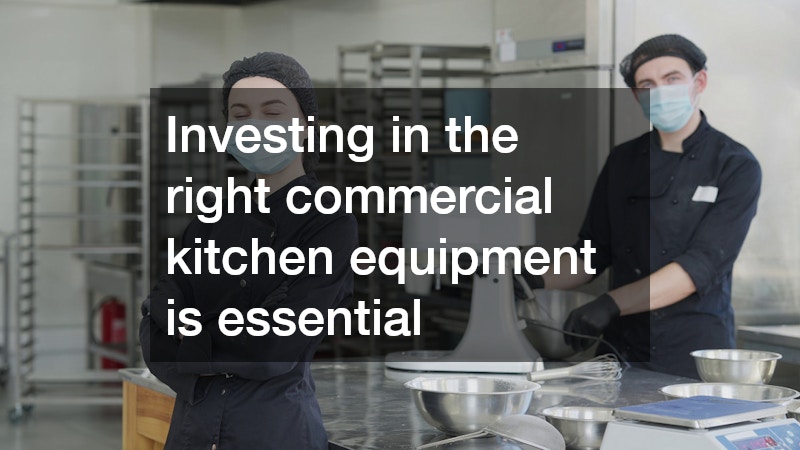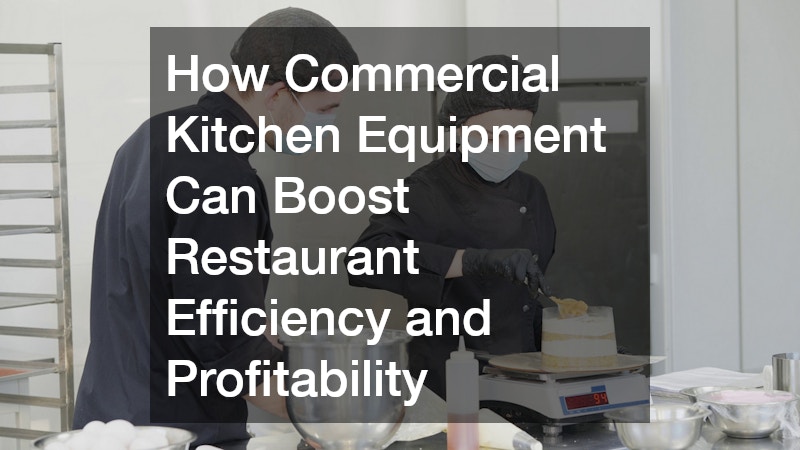
Running a successful restaurant requires more than just great food and service. Behind the scenes, efficient operations and smart investments play a critical role in profitability and long-term sustainability. One key factor that can significantly impact a restaurant’s performance is the quality and functionality of its kitchen tools. Commercial kitchen equipment is designed to meet the demands of busy foodservice environments, and when chosen thoughtfully, it can improve workflow, reduce costs, and ultimately boost the bottom line.
Enhancing Operational Efficiency
Efficiency in the kitchen translates directly into faster service and better customer experiences. Commercial kitchen equipment is specifically engineered to handle large volumes, withstand heavy use, and operate consistently throughout busy service hours. This reliability reduces downtime caused by equipment failure, allowing restaurants to meet customer demand without disruption.
High-performance appliances like convection ovens, commercial fryers, and industrial mixers help speed up food preparation and cooking processes. For example, convection ovens circulate hot air evenly, reducing cooking times and ensuring consistent results, while commercial fryers can handle multiple batches simultaneously, making popular fried dishes more efficient.
Moreover, modern commercial kitchen equipment often incorporates programmable features and automation. These technologies minimize human error by allowing chefs to set precise cooking times and temperatures. The result is a streamlined workflow where kitchen staff can focus on plating and quality control rather than constant monitoring, enhancing overall productivity.
Supporting Staff Productivity and Safety
A well-equipped kitchen empowers staff to perform their tasks effectively and safely. Commercial kitchen equipment designed with ergonomics and user-friendly interfaces reduces physical strain and fatigue, which can improve morale and reduce absenteeism. For instance, lightweight utensils, adjustable workstations, and easy-to-clean surfaces make day-to-day tasks less cumbersome.
In addition to comfort, safety features integrated into commercial kitchen equipment help prevent accidents. Automated shut-off valves, cool-touch handles, and splash guards protect employees from burns, cuts, and other hazards. Training staff on the proper use of these tools further decreases workplace injuries and helps maintain a positive work environment.
By investing in reliable and efficient equipment, restaurants also reduce the chances of workflow bottlenecks caused by equipment malfunction or inadequate capacity. When employees have the right tools, they can maintain steady production rates, which leads to quicker order fulfillment and higher customer satisfaction.
Improving Food Quality and Consistency
Consistency in food quality is vital for building customer loyalty and maintaining a strong brand reputation. Commercial kitchen equipment plays a crucial role in achieving this by providing precise control over cooking conditions and standardizing preparation methods.
For example, temperature-controlled ovens and grills ensure that dishes are cooked evenly and thoroughly every time. Consistent cooking helps preserve the intended flavors, textures, and appearance of menu items, making dining experiences predictable and enjoyable for patrons.
Additionally, equipment such as food processors and slicers allows chefs to prepare ingredients uniformly, which contributes to balanced flavors and professional presentation. Automated timers and programmable settings reduce the risk of overcooking or undercooking, maintaining the integrity of each dish.
Reducing Operational Costs and Waste
Though commercial kitchen equipment often requires a significant upfront investment, it can generate substantial cost savings over time. Energy-efficient models lower utility bills by using less electricity, gas, or water without compromising performance. Many manufacturers offer Energy Star-rated appliances designed to minimize environmental impact and operating expenses.
In addition to energy savings, commercial kitchen equipment reduces food waste by optimizing portion control and cooking accuracy. Precision scales, portion dispensers, and programmable cooking functions ensure ingredients are used efficiently and meals are prepared correctly, limiting overproduction and spoilage.
Preventive maintenance features and durable construction extend equipment lifespan, decreasing repair costs and the frequency of replacements. Reliable appliances minimize downtime that can lead to lost sales and increased labor expenses.
Adapting to Changing Trends and Demands
The foodservice industry is dynamic, with evolving customer preferences and technological advancements shaping how restaurants operate. Commercial kitchen equipment that offers flexibility and adaptability helps businesses stay competitive and meet changing market demands.
For instance, multifunctional appliances allow kitchens to prepare a variety of dishes without the need for multiple specialized tools. This adaptability supports menu innovation, enabling restaurants to respond quickly to dietary trends like plant-based options or international cuisines.
Smart kitchen equipment that integrates with digital ordering systems, inventory management, and real-time analytics enhances operational control and decision-making. These technologies improve efficiency, reduce errors, and provide insights that drive profitability.
Restaurants that embrace innovative commercial kitchen equipment position themselves to capitalize on emerging opportunities and maintain relevance in a fast-paced industry.
Investing in the right commercial kitchen equipment is essential for boosting restaurant efficiency and profitability. From enhancing operational workflows and supporting staff productivity to ensuring consistent food quality and reducing costs, these tools play a pivotal role in a successful foodservice operation. By choosing equipment that aligns with their unique needs and staying attuned to industry innovations, restaurant owners can create a competitive edge that leads to sustained growth and customer satisfaction.
Smart investment in commercial kitchen equipment not only improves daily operations but also lays the foundation for a thriving and profitable restaurant business.








